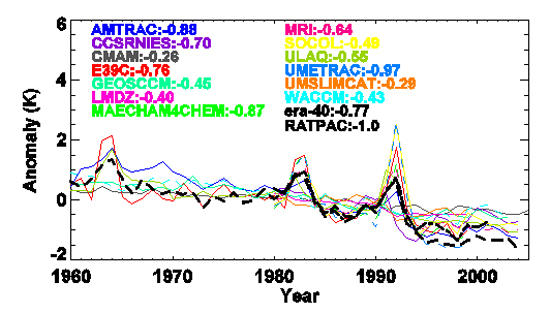Climate-Chemistry Interactions
The stratosphere is strongly sensitive to radiative perturbations, as caused for example by the observed decrease of stratospheric ozone (O3) and increases in well-mixed greenhouse gases (GHG) and water vapour (H2O) concentrations (e.g., Ramaswamy et al., 2001; Langematz et al., 2003). Changes in stratospheric composition lead to a radiative forcing, defined as the net change in radiative fluxes at the tropopause, and can be related to a forcing of climate (e.g., Chapter 5 in WMO, 2007).
The concentrations of the stratospheric climate forcing agents are controlled by atmospheric chemistry. Additionally, changes in tropospheric composition alter the stratospheric composition by the vertical transport into the stratosphere. Changes in climate impact significantly and in a non-linear fashion on the atmospheric chemistry, and hence change atmospheric composition, significantly. Satellite and radiosonde measurements reveal an overall cooling trend in the global-mean lower stratosphere of up to 1 K/decade over the period 1979-2005 (Figure 2).

Figure 2: The temperature anomalies are calculated for a mean reference period between 1980 and 1989. The numbers denote a linear trend in K/decade, calculated for the period 1980-1999. (Figure taken from WMO, 2007).
Future increases of GHG concentrations will contribute to a continued cooling in the stratosphere. As a number of chemical reaction rates in the atmosphere are dependent on temperature, the concentrations of chemical substances such as O3 are sensitive to temperature changes. For example, GHG-induced temperature and circulation changes are predicted by models currently to accelerate the global increase of O3 in the next decades, which might lead to a “super-recovery” of the O3 layer towards the end of this century, i.e. larger total O3 columns than observed around 1980 (e.g., Chapter 5 in WMO, 2007).

